TPMS HONDA ODYSSEY 2005 RB1-RB2 / 3.G Owners Manual
[x] Cancel search | Manufacturer: HONDA, Model Year: 2005, Model line: ODYSSEY, Model: HONDA ODYSSEY 2005 RB1-RB2 / 3.GPages: 414, PDF Size: 5.85 MB
Page 76 of 414
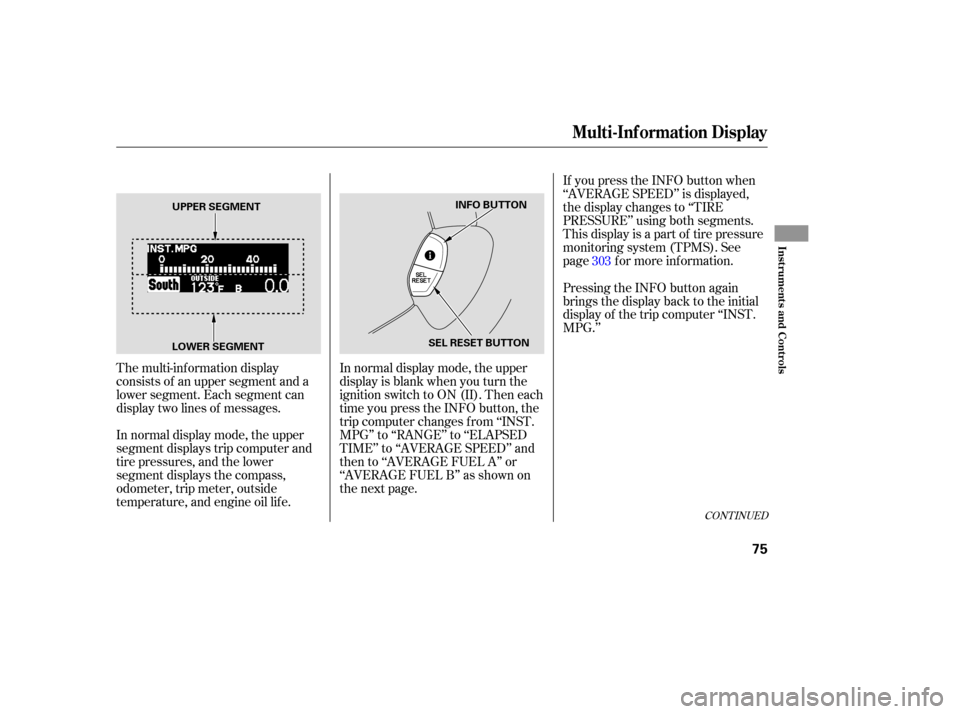
If you press the INFO button when
‘‘AVERAGE SPEED’’ is displayed,
the display changes to ‘‘TIRE
PRESSURE’’ using both segments.
This display is a part of tire pressure
monitoring system (TPMS). See
page f or more inf ormation.
The multi-inf ormation display
consists of an upper segment and a
lower segment. Each segment can
display two lines of messages.
In normal display mode, the upper
segment displays trip computer and
tire pressures, and the lower
segment displays the compass,
odometer, trip meter, outside
temperature, and engine oil lif e. In normal display mode, the upper
display is blank when you turn the
ignition switch to ON (II). Then each
time you press the INFO button, the
trip computer changes f rom ‘‘INST.
MPG’’ to ‘‘RANGE’’ to ‘‘ELAPSED
TIME’’ to ‘‘AVERAGE SPEED’’ and
then to ‘‘AVERAGE FUEL A’’ or
‘‘AVERAGE FUEL B’’ as shown on
the next page.Pressing the INFO button again
brings the display back to the initial
display of the trip computer ‘‘INST.
MPG.’’
303
CONT INUED
Multi-Inf ormation Display
Inst rument s and Cont rols
75
LOWER SEGMENT UPPER SEGMENT
INFO BUTTON
SEL RESET BUTTON
Page 84 of 414
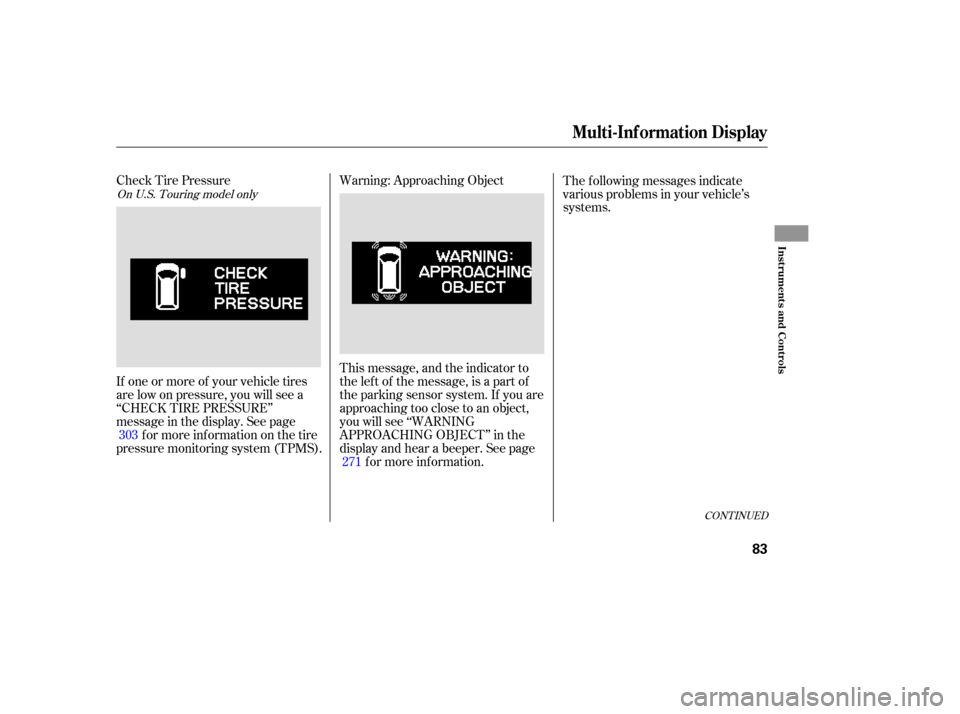
Check Tire PressureWarning: Approaching Object
This message, and the indicator to
the lef t of the message, is a part of
the parking sensor system. If you are
approaching too close to an object,
you will see ‘‘WARNING
APPROACHING OBJECT’’ in the
display and hear a beeper. See page
f or more inf ormation. The f ollowing messages indicate
various problems in your vehicle’s
systems.
If one or more of your vehicle tires
are low on pressure, you will see a
‘‘CHECK TIRE PRESSURE’’
message in the display. See page f or more inf ormation on the tire
pressure monitoring system (TPMS). 303
271
CONT INUED
On U.S. Touring model only
Multi-Inf ormation Display
Inst rument s and Cont rols
83
Page 85 of 414
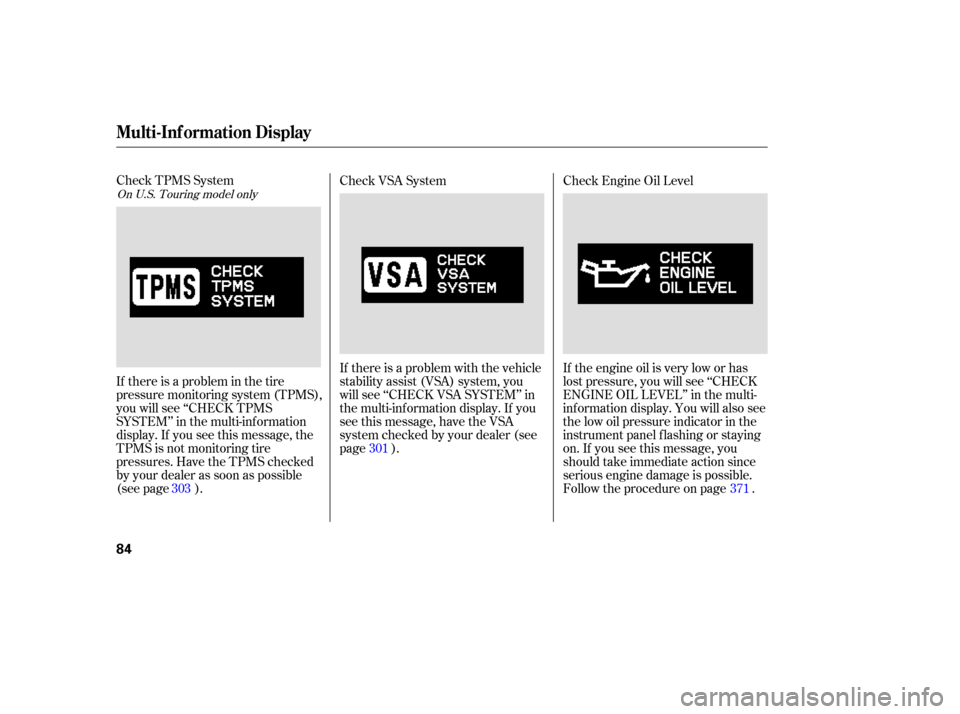
Check TPMS SystemIf there is a problem with the vehicle
stability assist (VSA) system, you
will see ‘‘CHECK VSA SYSTEM’’ in
the multi-information display. If you
see this message, have the VSA
system checked by your dealer (see
page ).If the engine oil is very low or has
lost pressure, you will see ‘‘CHECK
ENGINE OIL LEVEL’’ in the multi-
inf ormation display. You will also see
the low oil pressure indicator in the
instrument panel f lashing or staying
on. If you see this message, you
should take immediate action since
serious engine damage is possible.
Follow the procedure on page . Check Engine Oil Level
Check VSA System
If there is a problem in the tire
pressure monitoring system (TPMS),
you will see ‘‘CHECK TPMS
SYSTEM’’ in the multi-inf ormation
display. If you see this message, the
TPMS is not monitoring tire
pressures. Have the TPMS checked
by your dealer as soon as possible
(see page ). 301
303 371
On U.S. Touring model only
Multi-Inf ormation Display
84
Page 292 of 414

This section gives you tips on
starting the engine under various
conditions, and how to operate the
automatic transmission. It also
includes important inf ormation on
parking your vehicle, the braking
system, the vehicle stability assist
system, the tire pressure monitoring
system, and f acts you need if you are
planning to tow a trailer.........................
Preparing to Drive .292
.......................
Starting the Engine .293
..............
Automatic Transmission . 294
..................................
Parking Tips .298
.............................
Braking System .299
...............
Anti-lock Brakes (ABS) . 300
Vehicle Stability Assist (VSA) ........................................
System .301
Tire Pressure Monitoring System ......................................
(TPMS) .303
...........................
Towing a Trailer .306
Driving
Driving
291
Page 302 of 414

CONT INUED
If the VSA system indicator comes
on while driving, pull to the side of
theroadwhenitissafe,andturnoff
the engine. Reset the system by
restarting the engine. If the VSA
system indicator stays, or comes
back on while driving, have the VSA
system inspected by your dealer.
If the indicator does not come on
when the ignition switch is turned to
ON (II), there may be a problem
with the VSA system. Have your
dealer inspect your vehicle as soon
as possible.You will also see a ‘‘CHECK VSA
SYSTEM’’ message on the multi-
inf ormation display if there is a
problem with the VSA system.
The vehicle stability assist (VSA)
system helps to stabilize the vehicle
during cornering if the vehicle turns
more or less than desired. It also
assists you in maintaining traction
while accelerating on loose or
slippery road surf aces. It does this
by regulating the engine’s output,
and by selectively applying the
brakes.
The VSA system cannot enhance the
vehicle’s driving stability in all
situations and does not control your
vehicle’s entire braking system. It is
still your responsibility to drive and
corner at reasonable speeds and to
leave a sufficient margin of safety. When VSA activates, you may notice
that the engine does not respond to
the accelerator in the same way it
does at other times. When VSA activates, you will see the
VSA activation indicator blink.
If the low tire pressure indicator
comes on (see page ), or the
multi-inf ormation display shows a
‘‘CHECK TPMS SYSTEM’’ message
(see page ), the VSA system
automatically turns on even if you
turn it off with the VSA OFF button.66
84
On Touring model only
Vehicle Stability Assist (VSA) System
VSA A ctivation Indicator
VSA System Indicator
Driving
301
Page 304 of 414
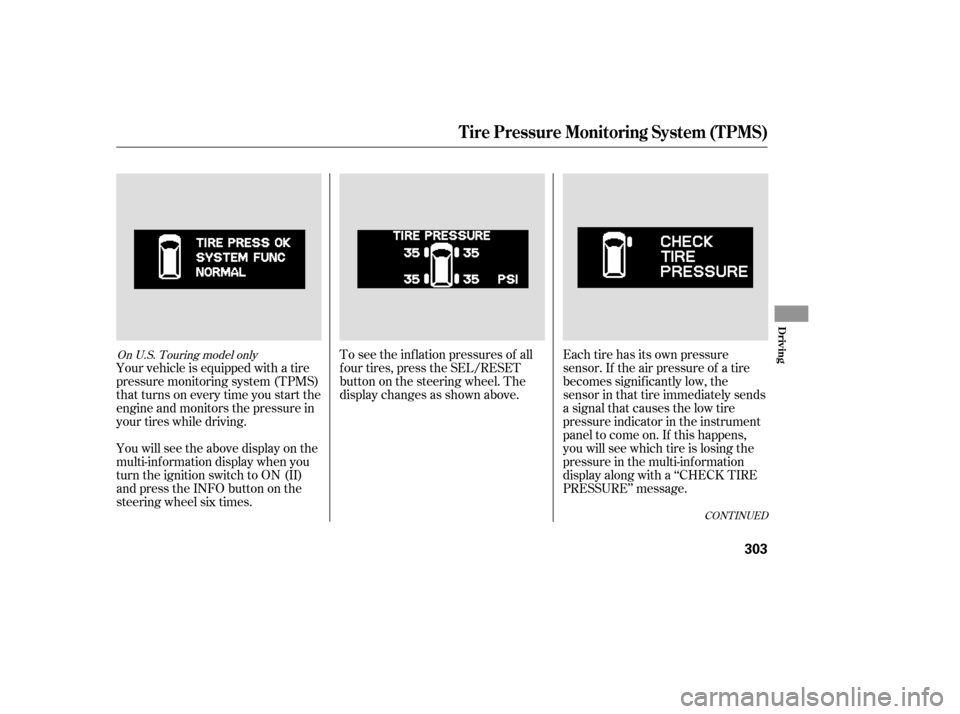
Your vehicle is equipped with a tire
pressure monitoring system (TPMS)
that turns on every time you start the
engine and monitors the pressure in
your tires while driving.
You will see the above display on the
multi-inf ormation display when you
turn the ignition switch to ON (II)
andpresstheINFObuttononthe
steering wheel six times.To see the inf lation pressures of all
f our tires, press the SEL/RESET
buttononthesteeringwheel.The
display changes as shown above.
Each tire has its own pressure
sensor. If the air pressure of a tire
becomes signif icantly low, the
sensor in that tire immediately sends
a signal that causes the low tire
pressure indicator in the instrument
panel to come on. If this happens,
you will see which tire is losing the
pressure in the multi-information
display along with a ‘‘CHECK TIRE
PRESSURE’’ message.
CONT INUED
On U.S. Touring model only
Tire Pressure Monitoring System (TPMS)
Driving
303
Page 305 of 414

If a f lat tire is causing the low tire
pressure indicator to come on, you
will see the above message in the
multi-inf ormation display.
It is possible that the pressures
shown in the multi-inf ormation
display and the pressures you
manually measure are slightly
dif f erent.
If the dif f erence is signif icant and
you cannot make the low tire
pressure indicator and message in
the multi-inf ormation display go out
after inflating the tires to the
specified values, have your dealer
check the system as soon as possible.
When the low tire pressure indicator
is on, one or more of your tires is
signif icantly under-inf lated. You
should stop and check your tires as
soon as possible, and inflate them to
the proper pressure as indicated on
the vehicle’s tire inf ormation placard.
Driving on a signif icantly under-
inf lated tire causes the tire to
overheat and can lead to tire failure.
Under-inf lation also reduces f uel
efficiency and tire tread life, and may
af f ect the vehicle’s handling and
stopping ability. Each tire, including
the spare should be checked
monthly when cold, and set to the
recommended inf lation pressure as
specif ied in the vehicle placard and
owner’s manual (see page ).
346
Tire Pressure Monitoring System (TPMS)
Low Tire Pressure
Indicator
304
Page 306 of 414
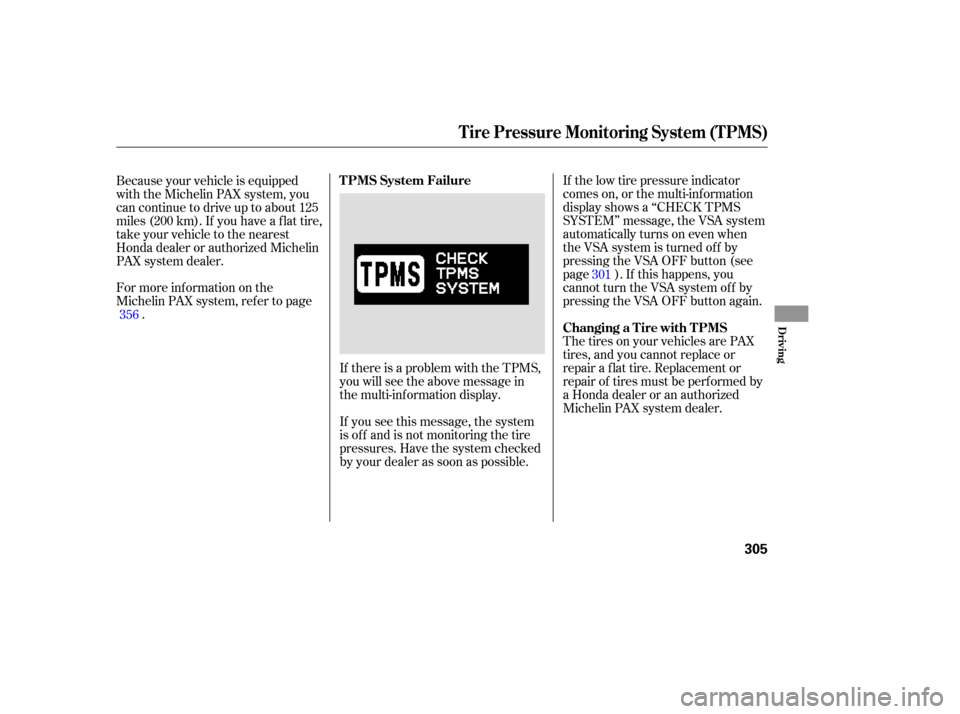
The tires on your vehicles are PAX
tires, and you cannot replace or
repair a f lat tire. Replacement or
repair of tires must be perf ormed by
a Honda dealer or an authorized
Michelin PAX system dealer. If the low tire pressure indicator
comes on, or the multi-information
display shows a ‘‘CHECK TPMS
SYSTEM’’ message, the VSA system
automatically turns on even when
the VSA system is turned of f by
pressing the VSA OFF button (see
page ). If this happens, you
cannot turn the VSA system of f by
pressing the VSA OFF button again.
If there is a problem with the TPMS,
you will see the above message in
the multi-information display.
If you see this message, the system
is of f and is not monitoring the tire
pressures. Have the system checked
by your dealer as soon as possible.
For more inf ormation on the
Michelin PAX system, ref er to page
.
Because your vehicle is equipped
with the Michelin PAX system, you
can continue to drive up to about 125
miles (200 km). If you have a f lat tire,
take your vehicle to the nearest
Honda dealer or authorized Michelin
PAX system dealer.
301
356
Tire Pressure Monitoring System (TPMS)
Changing a T ire with T PMS
TPMS System FailureDriving
305
Page 347 of 414

To saf ely operate your vehicle, your
tires must be the proper type and
size, in good condition with adequate
tread, and correctly inf lated.
The f ollowing pages give more
detailed inf ormation on how to take
care of your tires and what to do
when they need to be replaced.Keeping the tires properly inf lated
provides the best combination of
handling, tread lif e, and riding
comf ort.
Underinf lated tires wear unevenly,
adversely affect handling and fuel
economy, and are more likely to
fail from being overheated.
Overinf lated tires can make your
vehicleridemoreharshly,are
more prone to damage f rom road
hazards, and wear unevenly.
The tire pressure monitoring system
(TPMS) warns you when a tire
pressure is low. See page f or
more inf ormation.
We recommend that you visually
check your tires every day. If you
think a tire might be low, check it
immediately with a tire gauge. Thecompactsparetirepressureis:
303 LX and EX
EX with Leather and Canadian
Touring modelsTire Size
Tire Size Cold Tire Pressure for
Normal Driving
Front:
Rear:
Cold Tire Pressure for
Normal Driving
Front:
Rear:
On U.S. Touring model only
Tires
Inf lation Guidelines
346
235/65R16 103T 33 psi (230 kPa ,
2.3 kgf/cm)
35 psi (240 kPa , 2.4 kgf/cm
)
235/65R16 103T 35 psi (240 kPa ,
2.4 kgf/cm
)
35 psi (240 kPa , 2.4 kgf/cm
)
60 psi (420 kPa , 4.2 kgf/cm)
Using tires that are excessively
worn or improperly inflated can
cause a crash in which you can
be seriously hurt or killed.
Follow all instructions in this
owner’s manual regarding tire
inflation and maintenance.
Page 352 of 414

Your vehicle is equipped with the
Michelin PAX System which,
together with the Tire Pressure
Monitoring System (TPMS), enables
you to continue driving even if one or
more of your tires loses its pressure.
The tires and wheels on your vehicle
are specially designed f or the PAX
system, and the PAX system is
specif ically designed and f ine-tuned
foryourvehicle.
Because of these reasons, use only
the wheels and tires designated in
this owner’s manual. Never mix PAX
system wheels or tires with
conventional wheels or tires.There are no snow tires compatible
with the PAX system, and not all tire
chains are suitable f or use on the
PAX system tires. To prevent tire
chain damage to your PAX system
tire or wheel, ensure that no part of
the chain contacts the PAX system.
Never use a tire repair agent in a
PAX system tire, and never repair
a PAX system tire by yourself .
Repair or replacement must be
done a Honda dealer or an
authorized Michelin PAX system
dealer.
Do not replace the PAX system tires
and wheels with conventional tires
andwheels.Doingsowoulddisable
the PAX system and the tire
pressure monitoring system (TPMS),
and may void your new vehicle
warranty. If you must continue driving with a
f lat tire, f ollow all the procedures
and precautions described on page
.
356
On U.S. Touring model only
Tires
Michelin PA X SystemImport ant Precaut ions
Maint enance
351